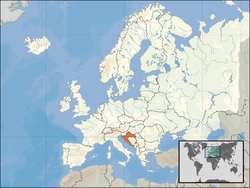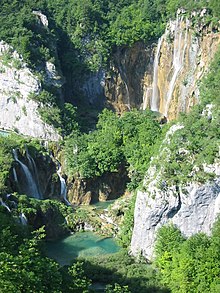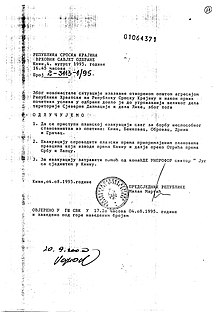| Revision as of 14:16, 13 May 2008 view source81.179.30.138 (talk)No edit summary← Previous edit | Revision as of 14:17, 13 May 2008 view source Epbr123 (talk | contribs)291,700 editsm Reverted edits by 81.179.30.138 (talk) to last version by CrypticNext edit → | ||
| Line 87: | Line 87: | ||
| == History == | == History == | ||
| {{main|History of Croatia}} | |||
| ] | |||
| The ] settled in the Balkans and formed two principalities, ] and ]. The establishment of the ] dynasty ca. 850 brought strengthening to the ] Croat duchy, which became a kingdom in 925. | |||
| In 1102 Croatia entered into a personal union with the ]. After the 1526 ], the "reliquiae reliquiarum" of Croatia became a part of the ] in 1527. In 1918 Croatia joined the ] into a Kingdom of Serbs, Croats and Slovenes (later ]). | |||
| In 1941-1945 during ], an ] ] known as the ] existed. After it suffered a defeat at the hand of the ], Croatia became a constitutive federal republic of the ]. | |||
| In 1991 Croatia proclaimed independence by holding the first democratic elections in the country but had to fight ] until 1995. | |||
| Croatia was recognized on ], ] by the ] and the ]. The first country to recognize Croatia was ] on ], ].<ref>{{cite web|url=http://www.sabor.hr/Default.aspx?art=1769&sec=461|title=Važniji datumi iz povijesti saborovanja|publisher=Hrvatski Sabor|accessdate=2008-04-23}}</ref> | |||
| Basics, croatia was formed when this guy was soo mashed that he was like ,"BLAH," and croatia was formed. | |||
| == Government and politics == | == Government and politics == | ||
| {{main|Politics of Croatia}} | {{main|Politics of Croatia}} | ||
Revision as of 14:17, 13 May 2008
| Republic of CroatiaRepublika Hrvatska | |
|---|---|
 Flag
Flag
 Coat of arms
Coat of arms
| |
| Anthem: Lijepa naša domovino Our beautiful homeland | |
 Location of Croatia (orange) Location of Croatia (orange) | |
| Capitaland largest city | Zagreb |
| Official languages | Croatian |
| Demonym(s) | Croat(s) Croatian(s) |
| Government | Parliamentary republic |
| • President | Stjepan Mesić |
| • Premier | Ivo Sanader |
| Establishment | |
| • Founded | First half of 7th century |
| • Medieval duchy | March 4 852 |
| • Recognized by the Pope | May 21 879 |
| • Elevated to kingdom | 925 |
| • Union with Hungary | 1102 |
| • Joined Habsburg Empire | January 1 1527 |
| • Independence from Austria-Hungary | October 29 1918 |
| • Joined Yugoslavia (co-founder) | December 1 1918 |
| • Declared independence | October 8 1991 |
| Area | |
| • Total | 56,542 km (21,831 sq mi) (126th) |
| • Water (%) | 0.2 |
| Population | |
| • 2008 estimate | 4,453,500 (114th) |
| • 2001 census | 4,437,460 |
| • Density | 81/km (209.8/sq mi) (115th) |
| GDP (PPP) | 2008 estimate |
| • Total | $74.419 billion (IMF) |
| • Per capita | $16,758 (IMF) (51st) |
| GDP (nominal) | 2008 estimate |
| • Total | $54.950 billion (IMF) |
| • Per capita | $12,374 (IMF) |
| Gini (2005) | 29 low inequality |
| HDI (2005) | Error: Invalid HDI value (47th) |
| Currency | kuna (HRK) |
| Time zone | UTC+1 (CET) |
| • Summer (DST) | UTC+2 (CEST) |
| Calling code | 385 |
| ISO 3166 code | HR |
| Internet TLD | .hr |
Croatia (Template:IPAEng) (Template:Lang-hr /xrvatska/), officially the Republic of Croatia (Republika Hrvatska listen), is a country at the crossroads of the Mediterranean, Central Europe, and the Balkans. Its capital is Zagreb. Croatia borders with Slovenia and Hungary to the north, Serbia to the northeast, Bosnia and Herzegovina to the east, and Montenegro to the far southeast. Its southern and western flanks border the Adriatic Sea.
Croatia is a member of United Nations, the Organization for Security and Co-operation in Europe, and the Council of Europe, is a candidate for membership of the European Union and received a NATO membership invitation on 3 April 2008. On October 17, 2007 Croatia became a non-permanent member of the United Nations Security Council for the 2008-2009 term.
History
Main article: History of Croatia
The Croats settled in the Balkans and formed two principalities, Dalmatia and Pannonia. The establishment of the Trpimirović dynasty ca. 850 brought strengthening to the Dalmatian Croat duchy, which became a kingdom in 925.
In 1102 Croatia entered into a personal union with the Kingdom of Hungary. After the 1526 Battle of Mohács, the "reliquiae reliquiarum" of Croatia became a part of the Habsburg Monarchy in 1527. In 1918 Croatia joined the Kingdom of Serbia into a Kingdom of Serbs, Croats and Slovenes (later Kingdom of Yugoslavia).
In 1941-1945 during World War II, an Axis puppet state known as the Independent State of Croatia existed. After it suffered a defeat at the hand of the Allies, Croatia became a constitutive federal republic of the Socialist Federal Republic of Yugoslavia.
In 1991 Croatia proclaimed independence by holding the first democratic elections in the country but had to fight a long and bloody war until 1995.
Croatia was recognized on January 15, 1992 by the European Union and the United Nations. The first country to recognize Croatia was Iceland on December 19, 1991.
Government and politics
Main article: Politics of Croatia See also: Foreign relations of Croatia, Accession of Croatia to the European Union, and International rankings of CroatiaSince the adoption of the 1990 Constitution, Croatia has been a democratic republic. Between 1990 and 2000 it had a semi-presidential system, and since 2000 it has a parliamentary system.
The President of the Republic (Predsjednik) is the head of state, directly elected to a five-year term and is limited by the Constitution to a maximum of two terms. In addition to being the commander in chief of the armed forces, the president has the procedural duty of appointing the Prime minister with the consent of the Parliament, and has some influence on foreign policy. His official residence is Predsjednički dvori. Apart from that he has summer residences on the islands of Vanga (Brijuni islands) and the island of Hvar.
The Croatian Parliament (Sabor) is a unicameral legislative body (a second chamber, the "House of Counties", which was set up by the Constitution of 1990, was abolished in 2001). The number of the Sabor's members can vary from 100 to 160; they are all elected by popular vote to serve four-year terms. The plenary sessions of the Sabor take place from January 15 to July 15, and from September 15 to December 15.
The Croatian Government (Vlada) is headed by the Prime minister who has two deputy prime ministers and fourteen ministers in charge of particular sectors of activity. The executive branch is responsible for proposing legislation and a budget, executing the laws, and guiding the foreign and internal policies of the republic. Government's official residence is at Banski dvori.
Geography
Main article: Geography of Croatia
Croatia is located in South-Central Europe. Its shape resembles that of a crescent or a horseshoe, which flanks its neighbours Serbia, Bosnia and Herzegovina and Montenegro. To the north lie Slovenia and Hungary; Italy lies across the Adriatic Sea. Its mainland territory is split in two non-contiguous parts by the short coastline of Bosnia and Herzegovina around Neum.
Its terrain is diverse, including:
- plains, lakes and rolling hills in the continental north and northeast (Central Croatia and Slavonia, part of the Pannonian Basin);
- densely wooded mountains in Lika and Gorski Kotar, part of the Dinaric Alps;
- rocky coastlines on the Adriatic Sea (Istria, Northern Seacoast and Dalmatia).
The country is famous for its many national parks. Croatia has a mixture of climates. In the north and east it is continental, Mediterranean along the coast and a semi-highland and highland climate in the south-central region.
Offshore Croatia consists of over one thousand islands varying in size. The largest islands in Croatia are Cres and Krk which are located in the Adriatic Sea. The Danube, the second longest river in Europe, runs through the city of Vukovar.
Counties
Main article: Counties of Croatia See also: List of cities in Croatia
Croatia is divided into 20 counties (županija) and the capital Zagreb's city district (in italics below):
| Anglicized name | Native name | |
| 1 | Zagreb | Zagrebačka |
| 2 | Krapina-Zagorje | Krapinsko-zagorska |
| 3 | Sisak-Moslavina | Sisačko-moslavačka |
| 4 | Karlovac | Karlovačka |
| 5 | Varaždin | Varaždinska |
| 6 | Koprivnica-Križevci | Koprivničko-križevačka |
| 7 | Bjelovar-Bilogora | Bjelovarsko-bilogorska |
| 8 | Primorje-Gorski Kotar | Primorsko-goranska |
| 9 | Lika-Senj | Ličko-senjska |
| 10 | Virovitica-Podravina | Virovitičko-podravska |
| 11 | Požega-Slavonia | Požeško-slavonska |
| 12 | Brod-Posavina | Brodsko-posavska |
| 13 | Zadar | Zadarska |
| 14 | Osijek-Baranja | Osječko-baranjska |
| 15 | Šibenik-Knin | Šibensko-kninska |
| 16 | Vukovar-Srijem | Vukovarsko-srijemska |
| 17 | Split-Dalmatia | Splitsko-dalmatinska |
| 18 | Istria | Istarska |
| 19 | Dubrovnik-Neretva | Dubrovačko-neretvanska |
| 20 | Međimurje | Međimurska |
| 21 | City of Zagreb | Grad Zagreb |
Demographics

The population of Croatia has been stagnating over the last decade. During the 1991-1995 war, large sections of the population were displaced and emigration increased. Many ethnic Serbs fled Croatia during this time. All in all between 200,000 and 300,000 Serbs left Croatia. Around 78,000 Croats were forcibly removed from the self-proclaimed Republic of Serb Krajina, which has now been re-integrated into Croatia, although some later returned. Only a minority of Serbs have returned to Croatia since 1995. The natural growth rate of the population is currently negative with the demographic transition completed half a century ago. Average life expectancy is 75.1 years, and the literacy rate is 98.1 per cent.
Croatia is inhabited mostly by Croats (89.9 per cent of the population). There are around twenty minority groups. Serbs, are largest minority, comprising 4.5 per cent of the total population. The predominant religion is Catholicism (87.8 per cent), with some Orthodox (4.4 per cent) and Sunni Muslim (1.3 per cent) minorities.
The official and common language, Croatian, is a South Slavic language, using the Latin alphabet. According to the 2001 census, 96.1 per cent of the population speak Croatian as their first language.
Law
Croatia has a three-tiered judicial system, consisting of the Supreme Court, county courts, and municipal courts. The Constitutional Court rules on matters regarding the Constitution.
Economy
Main article: Economy of Croatia
The Croatian economy has a stable functioning market economy which is one of the most advanced of South-Eastern Europe. International Monetary Fund data shows that Croatian nominal GDP stood at US$50.053 billion, or US$11,271 per capita, in 2007. The IMF forecast for 2008 is US$54.950 billion, or US$12,374 per capita. In purchasing power parity terms, total GDP was US$69.866 billion in 2007, equivalent to US$15,733 per capita. For 2008, it is forecast to be US$74.419 billion, or US$16,758 per capita.
According to Eurostat data, Croatian PPS GDP per capita stood at 53.4 per cent of the EU average in 2007, and is forecast to reach 54.1 per cent in 2008. Real GDP growth in 2007 was 6.0 per cent. The average gross salary in 2007 was 6,634 kuna per month. In 2007, the International Labour Organization-defined unemployment rate stood at 9.1 per cent, after falling steadily from 14.7 percent in 2002. The registered unemployment rate is higher, though, standing at 14.7 percent in December 2007.
In 2007, 7.2 percent of economic output was accounted for by agriculture, 32.8 percent by industry and 60.7 percent by the service sector. According to 2004 data, 2.7 percent of the workforce were employed in agriculture, 32.8 percent by industry and 64.5 in services.
The industrial sector is dominated by shipbuilding, food processing and the chemical industry. Tourism is a notable source of income during the summer, with over 10 million foreign tourists in 2006 generating a revenue of €8 billion. Croatia is ranked as the 18th most popular tourist destination in the world. In 2006 Croatia exported goods to the value of USD$10.4 billion (FOB) (US$19.7 billion including service exports).
Of particular concern is the backlogged judiciary system, combined with inefficient public administration, especially issues of land ownership and corruption. Another main problem includes the large and growing national debt which has reached over 30 billion dollars.
The country has been preparing for membership in the European Union, its most important trading partner. In February 2005, the Stabilisation and Association Agreement with the EU officially came into force.
Education
Primary education in Croatia starts at the age of six or seven and consists of eight grades. Secondary education is provided by gymnasiums and vocational schools.
Croatia has seven universities, the University of Zagreb, University of Split, University of Rijeka, University of Osijek, University of Zadar, University of Dubrovnik and the University of Pula. The University of Zagreb was founded in 1669 and is therefore the oldest in Southeastern Europe. There are also polytechnic higher education institutions.
Transport
Croatia has an extensive rail network, although due to historical circumstances, the Istria region is not accessible by train without passing through neighbouring Slovenia. Train services are operated by Croatian Railways (Template:Lang-hr). Major airports are located in in Zagreb, Zadar, Split, Dubrovnik, Rijeka (on the island of Krk), Osijek, Bol, Lošinj and Pula. Croatia Airlines is the national airline and flag carrier. An extensive system of ferries, operated by Jadrolinija, serves Croatia's many islands and links coastal cities. Ferry services are also available to Italy.
Culture
Main article: Culture of Croatia
Croatian culture is the result of a thirteen century-long history which has seen the development of many cities and monuments. The country includes six World Heritage sites and eight national parks. Croatia is also the birthplace of a number of historical figures included among the notable people are three Nobel prize winners, and numerous inventors.
Some of the world's first fountain pens came from Croatia. Croatia also has a place in the history of clothing as the origin of the necktie (kravata). The country has a long artistic, literary and musical tradition. Also of interest is the diverse nature of Croatian cuisine.
Sport
Main article: Sport in CroatiaSports popular in Croatia include association football, tennis, basketball, waterpolo and handball. The Croatian national football team finished third in the 1998 FIFA World Cup. The country failed in its joint bid with Hungary to co-host the 2012 European Championships. Tennis player Goran Ivanišević is one of the country's most recognisable sportsmen, and won the 2001 men's singles title at Wimbledon. The national basketball team finished third at the 1994 FIBA World Championship, second at the 1992 Summer Olympics and third at EuroBasket 1993 and 1995.
See also

- Communications in Croatia
- Holidays in Croatia
- Military of Croatia
- Protected areas of Croatia
- Tourism in Croatia
- Transport in Croatia
- Sport in Croatia
- Croatian War of Independence
- List of Croatians
- Law enforcement in Croatia
- International rankings of Croatia
- Banovina of Croatia
References
- ^ "World Economic Outlook Database". International Monetary Fund. October 2007. Retrieved 2008-03-09.
- "Važniji datumi iz povijesti saborovanja". Hrvatski Sabor. Retrieved 2008-04-23.
- "Croatia marks Storm anniversary". BBC News. 2005-08-05. Retrieved 2008-04-23.
- "Croatia: Operation "Storm" - still no justice ten years on". Amnesty International. 2005-08-04. Retrieved 2008-04-23.
- "Milan Babic - Initial Indictment". ICTY. Retrieved 2007-06-12.
- ^ "Croatia". CIA World Factbook. 2008-03-06. Retrieved 2008-03-09.
{{cite web}}: Italic or bold markup not allowed in:|publisher=(help) - "GDP per capita in PPS". Eurostat. Retrieved 2008-03-09.
- "Real GDP growth rate". Eurostat. Retrieved 2008-03-09.
- "Statistical Information 2007" (PDF). Republic of Croatia Central Bureau of Statistics. Retrieved 2008-03-09.
- "Unemployment rate – total". Eurostat. Retrieved 2008-03-09.
- "Bulletin 134" (PDF). Croatian National Bank. February 2008. Retrieved 2008-03-22.
- ^ "UNWTO World Tourism Barometer" (PDF). October 2007. Retrieved 2008-04-23.
Further reading
- Branka Magaš. "Croatia Through History: The Making of a Modern European State" Saqi. November 2007, 680pp.
- Agičić et al., Povijest i zemljopis Hrvatske, priručnik za hrvatske manjinske škole (History and Geography of Croatia, a handbook for Croatian minority schools), Biblioteka Geographica Croatica, 292 pages, Zagreb:2000 (ISBN 953-6235-40-4) Template:Hr icon
- Ivo Banac, The National Question in Yugoslavia: Origins, History, Politics Cornell University Press, 1984.
- Mirjana Kasapovic (ur.), Hrvatska politika 1990.-2000. Zagreb: Hrvatska politologija 2001.
- Pavol Demes and Joerg Forbrig (eds.), Reclaiming Democracy: Civil Society and Electoral Change in Central and Eastern Europe. German Marshall Fund, 2007. ISBN 978-80-969639-0-4
- Sharon Fisher, Political Change in Post-Communist Slovakia and Croatia: From Nationalist to Europeanist. New York: Palgrave Macmillan, 2006 ISBN 1 4039 7286 9
External links
- About Croatia
- Croatian National Tourist Board
- Croatian Tourist Forum
- The Government of the Republic of Croatia
| Within Croatia | ||||||||||||||||||||||||||||||||||||
|---|---|---|---|---|---|---|---|---|---|---|---|---|---|---|---|---|---|---|---|---|---|---|---|---|---|---|---|---|---|---|---|---|---|---|---|---|
| ||||||||||||||||||||||||||||||||||||
| International membership and history | |||||||||||||||||||||||||||||||||||||||||||||||||||||||||||||||||||||||||||||||||||||||||||||||||||||||||||||||||||||||||||||||||||||||||||||
|---|---|---|---|---|---|---|---|---|---|---|---|---|---|---|---|---|---|---|---|---|---|---|---|---|---|---|---|---|---|---|---|---|---|---|---|---|---|---|---|---|---|---|---|---|---|---|---|---|---|---|---|---|---|---|---|---|---|---|---|---|---|---|---|---|---|---|---|---|---|---|---|---|---|---|---|---|---|---|---|---|---|---|---|---|---|---|---|---|---|---|---|---|---|---|---|---|---|---|---|---|---|---|---|---|---|---|---|---|---|---|---|---|---|---|---|---|---|---|---|---|---|---|---|---|---|---|---|---|---|---|---|---|---|---|---|---|---|---|---|---|---|
Template:Slavic-speaking states
| |||||||||||||||||||||||||||||||||||||||||||||||||||||||||||||||||||||||||||||||||||||||||||||||||||||||||||||||||||||||||||||||||||||||||||||

